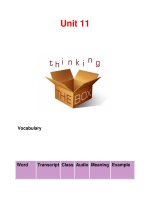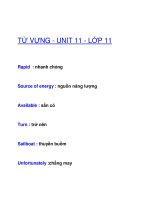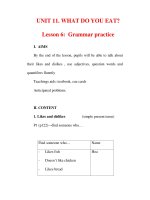E6 đọc unit 11
Bạn đang xem bản rút gọn của tài liệu. Xem và tải ngay bản đầy đủ của tài liệu tại đây (218.73 KB, 2 trang )
Full name: ...............................................
ENGLISH LANGUAGE TEST
Class: ......................................................
Time: 15 minutes
I. READING
1. Read the passage. Circle A, B or C to answer each question.
Facts about ocean pollution
Plastic elements are most often found in the ocean. More than 45,000 pieces of plastic float in every
square mile of ocean. Plastic is harmful and it does not break down easily.
Thousands of tons of waste and trash are thrown into the ocean every day.
Small animals take in chemical in their food. Then these small animals become food for larger animals.
Finally, the largest animals at the upper level of food chain become contaminated.
Over one million sea birds and one hundred thousand sea mammals are killed by ocean pollution each
year.
In some parts of the world such as Gulf of Mexico and the Baltic Sea, there are huge
dead zones. There are no marine and plant lives here.
1. What is the passage mainly about?
A. the sea pollution facts
B. the harm of plastic
C. the dead zones of the world
2. What is NOT mentioned about plastic in the passage?
A. It is harmful to environment.
B. It doesn’t break down easily.
C. It is thought as food by animals.
3. Which part of the world can we find dead zones?
A. Gulf of Mexico
B. Pacific Ocean
C. Indian Ocean
4. What is NOT true about ocean pollution?
A. It causes the dead of sea animals.
B. It makes plant lives impossible.
C. It provides food for sea animals.
5. What is mentioned about sea animals?
A. Small animals become larger animals.
B. Larger animals live at the upper part of the sea.
C. They all belong to a food chain.
2. Read the passage. Decide if the statements are true (T) or false (F). Circle T or F.
How Singaporeans go green? First, Singaporeans drink NEWater – recycled water. NEWater is suitable for
drinking. Second, they go green in shopping. They can now produce more organic goods. Stores have more
friendly options for buyers. Third, buildings in Singapore can be “green” too.They use ceramic tiles to reduce
pollution in the air. Now 25% of their buildings get Green Mark. By 2030, 80% of their buildings will get this.
Singapore can also produce “eco-friendly” cars. They also encourage people to walk or
travel by public transport. Finally, they now have more green-collar workers. These are
people who manage buildings, work in green industry, or plan green events.
1. NEW ater is recycled water and it is not suitable for drinking.
T
F
2. Singapore can produce more organic goods.
T
F
3. Buildings in Singapore become greener because they plant trees inside.
T
F
4. Singapore encourages more people to use eco-friendly cars.
T
F
5. The word ‘this’ refers to Green Mark.
T
F
The end
manual page break
Đáp án
I. READING
1. Read the passage. Circle A, B or C to answer each question.
1. A 2. C 3. A 4. C 5. C
2. Read the passage. Decide if the statements are true (T) or false (F). Circle T or F.
1. F 2. T 3. F 4. F 5. T









